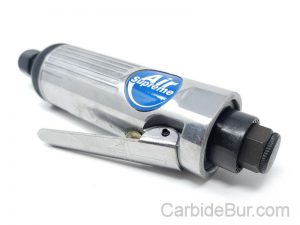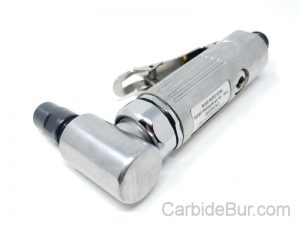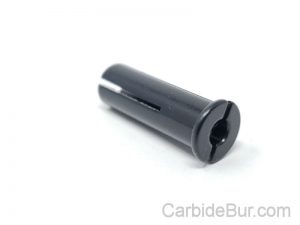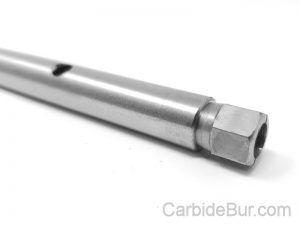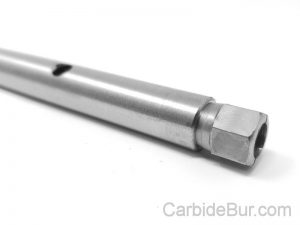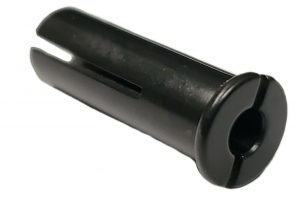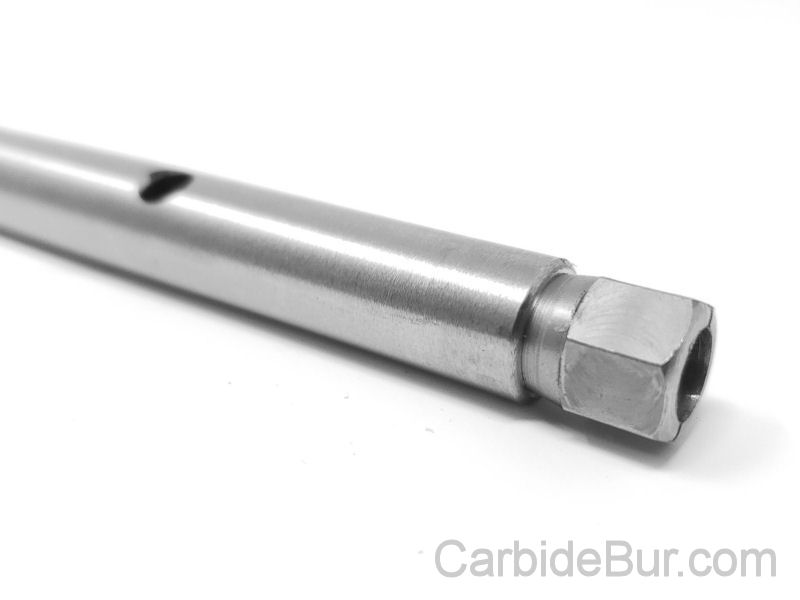Carbide Tool Accessories
We offer a huge selection of carbide tool accessories and carbide bur cutting tool die grinder bits. 1/4″ carbide burs on 1/8″ heat treated steel shanks
Rear Exhaust Die Grinder
1/4″ shank capacity
Angle Head Die Grinder
1/4″ shank capacity
Reducer Collet Adapter
Reduces 1/4″ to 1/8″ for your die grinder
4″ Carbide Bur Die Grinder Bit Extension Tool
Extension Diameter: 7/16″
Shank Diameter: 1/4″
Shank Length: 1″
Overall Length: 4″
9″ Carbide Bur Die Grinder Bit Extension Tool
Extension Diameter: 7/16″
Shank Diameter: 1/4″
Shank Length: 1″
Overall Length: 9″
How to Choose the Best Carbide Burs and Die Grinder Bits for Your Projects
Selecting the right carbide burs and die grinder bits can significantly enhance the quality and efficiency of your projects, whether you’re a DIY enthusiast, a skilled metalworker, or a professional in manufacturing and construction. With a vast array of carbide tool accessories available, understanding the nuances between different types can be daunting but crucial for achieving optimal results. From 1/4 inch carbide burs designed for precision work to those mounted on heat-treated steel shanks for added durability, each option serves a specific purpose. In this guide, we’ll delve into the essential factors to consider when choosing cutting tools and industrial tools, ensuring you have the best metalworking tools to tackle any project with confidence. Join us as we explore the key elements that will help streamline your tool selection process and boost your craftsmanship.
Understanding Carbide Burs
Carbide burs are essential tools used in various applications across industries. They are known for their durability and precision, making them a staple in many workshops. In this section, we’ll explore the different types of carbide burs, how to choose the right ones for your project, and specifically, the advantages of using 1/4 inch carbide burs.
Types of Carbide Burs
Carbide burs come in a variety of shapes and sizes, each designed for specific functions. Cylinder burs are perfect for surface milling, while ball-shaped burs excel in concave surface work. The pointed tree bur is ideal for corners and tight spaces, and inverted cone burs are great for cutting at angles.
Understanding the different types helps in selecting the right tool for the job. A cross-cut bur provides a smoother finish, whereas a single-cut is better for hard materials. The 22 Things to Know About Tungsten Carbide Burrs article provides insights into selecting the most suitable bur for your needs.
Precision, durability, and the ability to withstand high temperatures make carbide burs a popular choice. The diverse range ensures that there’s a suitable carbide bur for every application, ensuring efficiency and precision in your projects.
Choosing the Right Carbide Burs
Selecting the appropriate carbide bur involves understanding your project’s requirements. Identify the material you’ll be working with, as some burs are better suited for metals, while others are ideal for wood or plastic.
-
Assess the material: Determine the hardness and thickness.
-
Define the purpose: Is it for cutting, shaping, or finishing?
-
Match the bur shape to the task: Cylinder for flat surfaces, ball for curves, etc.
Consider the Burr Bits Guide for detailed advice on selecting burs for specific tasks. The right choice can significantly enhance efficiency and the quality of your work.
Finally, think about the size and diameter. Larger burs remove more material but sacrifice precision. Conversely, smaller burs provide finer details but take longer to complete tasks. Balancing these factors is key to effective tool selection.
Benefits of 1/4 Inch Carbide Burs
The 1/4 inch carbide burs are favored for their precision and versatility. They are particularly useful for detailed work in metalworking and other intricate tasks. Thanks to their size, they offer a balance between material removal and fine detail work.
These burs are mounted on heat-treated steel shanks, providing additional strength and durability. This feature makes them suitable for extended use without compromising performance or risking breakage. The Carbide Bur Resources website offers a range of options to suit different projects.
Key benefits include:
-
Durability: Enhanced lifespan due to carbide composition.
-
Versatility: Suitable for a wide range of materials and applications.
-
Precision: Ideal for detailed and delicate tasks.
Incorporating these features into your toolkit can improve both the efficiency and outcome of your projects.
Selecting Die Grinder Bits
Die grinder bits are vital for finishing and detailing work. The selection process involves understanding the materials used in the bits, matching them to your projects, and ensuring their maintenance for longevity. Here, we explore these crucial aspects in detail.
Die Grinder Bit Materials
Die grinder bits are made from several materials, each offering distinct advantages. Tungsten carbide is a popular choice due to its hardness and heat resistance. It’s perfect for cutting through tough materials like metal and stone.
-
Steel: Less durable but cost-effective, suitable for softer materials.
-
Diamond-coated bits: Best for precision and hard surfaces like glass and ceramics.
-
Aluminum oxide: Ideal for grinding and smoothing.
For more insights, the Grassroots Motorsports Forum discusses the best die grinder bit sets, helping users select the right tools for their needs.
When choosing materials, consider the project requirements, budget, and material characteristics to ensure optimal performance and cost-efficiency.
How to Match Bits with Projects
Matching die grinder bits to your projects involves a few key steps. Start by identifying the material you’ll work on, then select a bit that compliments this material. The right bit enhances both the process and the final result.
-
Identify the material: Metal, wood, plastic, etc.
-
Choose the appropriate bit: Based on material type and project requirements.
-
Consider precision needs: Use fine bits for detailed work, coarse bits for bulk removal.
Using the correct bit not only improves efficiency but also extends the life of both the bit and the tool. The Burr Bits Guide provides detailed insights on aligning bits with specific projects.
Finally, ensure the bit size is compatible with your die grinder. Proper fitment is essential for safe and effective tool use.
Maintenance of Die Grinder Bits
Maintaining die grinder bits is crucial for prolonged use and optimal performance. Regular cleaning and proper storage prevent wear and tear, ensuring the bits remain sharp and effective.
-
Clean after use: Remove debris and residue.
-
Store in a dry place: Avoid rust and corrosion.
-
Inspect regularly: Check for damage or wear.
Scheduled maintenance routines not only extend the life of your bits but also ensure consistent performance. For comprehensive maintenance tips, the 22 Things to Know About Tungsten Carbide Burrs is a valuable resource.
Implementing these practices ensures your die grinder bits remain in top condition, ready for any project challenge.
Enhancing Your Projects
Enhancing your projects requires more than just the right tools; it involves understanding how to effectively integrate these tools into your workflow. This section discusses the importance of heat-treated steel shanks, integrating cutting tools in metalworking, and using industrial tools effectively.
Importance of Heat Treated Steel Shanks
Heat-treated steel shanks provide increased durability and strength to carbide burs and grinder bits. This process involves heating the steel to alter its properties, resulting in a tougher, more resilient tool component.
-
Enhanced strength: Reduces the likelihood of snapping or bending.
-
Improved durability: Extends the tool’s operational life.
-
Better performance: Maintains integrity under high stress.
Using tools with heat-treated shanks can significantly reduce wear and tear, particularly during intensive tasks. The Carbide Bur Resources website highlights products with these enhanced features, ensuring you have reliable tools for demanding jobs.
Overall, the integration of heat-treated shanks into your toolset ensures reliability and efficiency, which are crucial for high-quality project outcomes.
Integrating Cutting Tools in Metalworking
Integrating cutting tools into metalworking requires understanding both the tools and the materials. Cutting tools are designed to efficiently remove material, shape, or finish workpieces to precise specifications.
-
Select appropriate cutting tools: Based on the workpiece material.
-
Ensure tool compatibility: With the machinery being used.
-
Optimize cutting speeds and feeds: For efficient operation.
Utilizing cutting tools effectively can improve workflow and reduce waste. The Burr Bits Guide provides valuable insights on selecting and using these tools in metalworking.
Proper integration of cutting tools into your processes not only enhances the quality of work but also contributes to operational efficiency.
Using Industrial Tools Effectively
Using industrial tools effectively involves a combination of correct tool selection, proper technique, and regular maintenance. Each of these elements is crucial for maximizing the potential of your toolset.
-
Select the right tool for the job: Ensure the tool is designed for the task.
-
Employ proper techniques: Follow best practices for operation.
-
Maintain tools regularly: Preventative maintenance ensures longevity.
The Grassroots Motorsports Forum offers real-world insights into utilizing industrial tools for various applications.
By focusing on these aspects, you can maximize the efficiency and effectiveness of your industrial tools, leading to improved productivity and project outcomes.
We manufacture single, double, and aluminum cut carbide bur cutting tools. We will tell you the differences between single, double and aluminum cuts, and when to use them.
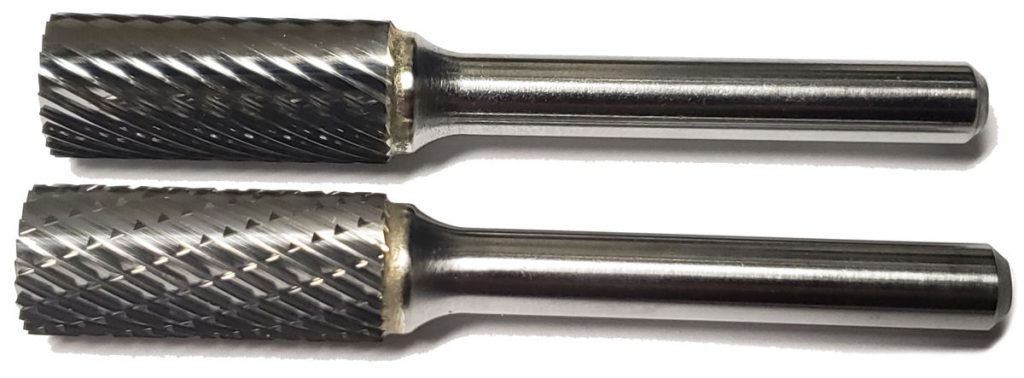
Choose Double, Single or Aluminum Cut 1/4″ Carbide Bur?
![]()
Our double cut carbide burs allow for rapid stock removal in harder materials. The addition of the left hand flutes reduces the pulling action, allowing better operator control. You can reduce the size of the chips and use them at slower than normal speeds using our double cut burs.

Our single cut carbide burs are for general purpose and designed for cast iron, steel, some copper and brass, and other ferrous materials. Single cut will give good material removal and good workpiece finishes.
Non-ferrous are exactly what you would expect them to be. Use our cutting tools on non-ferrous materials such as aluminum, copper and magnesium.
Our USA made tungsten carbide burrs can be used on most hard materials including steel, aluminum and cast iron, all types of stone, ceramic, porcelain, hard wood, acrylics, fibreglass and reinforced plastics. If you use our burs on soft metals such as gold, platinum and silver, carbide burrs are perfect as they will last for a long time with no breaking or chipping.
Different cuts of carbide burrs will be best suited for certain materials.
Try our 1/4” to 1/8” Collet Reducer
Allows you to use 1/8” shank carbide bits in your 1/4” die grinder
Uses for 1/4″ Carbide Bur Die Grinder Bits
Carbide burs are widely used in metalworking, tool making, engineering, model engineering, wood carving, jewelry making, welding, chamferring, casting, deburring, grinding, cylinder head porting and sculpting. Our carbide cutting tools are used in the aerospace, automotive, dentistry, stone and metalsmith industries.
Carbide burs (burrs) are tools that are used for precision in cutting, grinding, and shaping the material
with which they are being worked. Additionally, you can use them for deburring, where burrs, excess
materials, sharp edges, and weld beads are removed. Use carbide burs in industrial tools, such as air
tools (e.g., die grinders), engravers, flexible shafts, and pendant drills, as well as for hobbies (e.g.,
Dremel tools). Their uses are varied and diverse, such as jewelry work, metalworking, welding,
woodworking, and cover a range of industries, including aeronautics, aviation, automotive, dentistry,
and metal and stone working.
Need a longer reach?
Try our 4″ and 9″ extension tool for your carbide bur bits
Carbide burs (burrs) are composed of titanium or tungsten; diamond is the only material on
the Mohs scale that is harder and also used for drill tips. This means they are ideal for multiple purposes
due to the fact that they maintain sharper cutting edges for longer periods of time due, and tolerate
higher temperatures without warping when you apply friction. Carbide burs (burrs) maintain their sharp edges 10-20 times longer than a stainless-steel bur (burr), depending on the frequency of use and the materials used with.
All our USA made carbide bur cutting tools ship SAME DAY ordered by USPS Mail with online tracking.
We can also dropship the carbide bur die grinder bit, if interested in joining our FREE dropship program.
We accept debit and all major credit card payments including Visa, MasterCard, Discover, American Express and PayPal. Fast and easy secure checkout with no account or login required. If you have any questions, visit our FAQ page or contact us here.

Follow us on Facebook, Twitter and Instagram
Return to CarbideBur.com
Carbide Burs – 1/4″ on 1/8″ Shanks – Accessories – Aluminum Cut – Bur Sets – End Mills – Long Shank – Solid Burs

